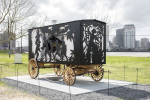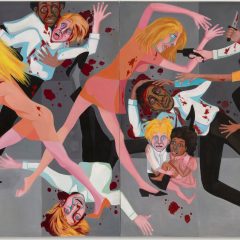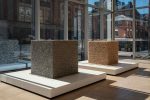This week’s Weekly has my essay dealing with emotional heat in some local art. Below is the copy and here’s the link to the art page. For more pictures of these shows check my flickr sites for Saving Faces, for Caleb Weintraub and Mauro Zamora, and the ICA. Libby has some good shots of the ICA show here.
Heat and Why It Matters
Taking posterity head on.
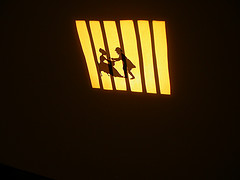
Kara Walker’s cut paper and projected light piece in Fables at ICA.
In today’s global art scene—where a Malaysian artist making abstract paintings in Brooklyn can show work in a Philadelphia gallery—it’s hard to place value and pass judgment. Where once critical context was filtered through the narrow lens of theory or regionalism, now the lens is wide-angled. It must encompass the globe and embrace all venues and all theories. And why not? Everything is available at the click of a mouse, so why not look at and consider it all?
What stands out in this otherwise overwhelming flow of art is work that conveys passion and heat. I don’t mean things that are merely loud or noisy or full of red. Passion in art conveys itself with energy, focus and humanity. Art by self-taught artists has this inner-fueled heat, which explains why this art is now so popular.
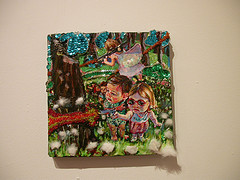
Caleb Weintraub at Projects. A small but heated painting. Click to see it bigger.
Passion is a good yardstick for measuring art. Among work I’ve seen locally with this fire in the belly are Caleb Weintraub’s paintings at Projects Gallery, the exhibition “Fables” at the ICA, Mauro Zamora’s wall painting at Seraphin, and Mark Gilbert’s paintings of facially deformed patients at Klein Art. This isn’t an exhaustive list but reflects some thoughts about heat produced by a variety of artists in a variety of venues.
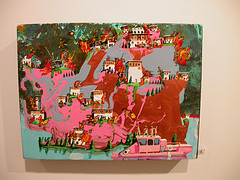
Caleb Weintraub. In addition to the large works with the militant babies there’s many small works that have an almost Indian miniature-like quality. Many of those use collage material –everything from cut paper to styrofoam bits and glitter.
Weintraub’s red-hot imagery depicts militant gun-toting babies and apocalyptic Candylands. You can feel the artist’s distress about the subject matter. These works are Boschian dystopias full of beautifully executed details and surreal conceits. Their message about the horror of excess keeps on coming.
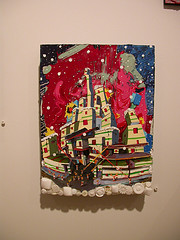
Here’s an example of a Weintraub collage painting. In all the paintings, the theme is that tribe of angry and destructive children who have taken over the world. The artist, who lives in Bloomington, IN, has two children and told Gallerist Helen Meyrick that he’s toned down his paintings since the birth of his children.
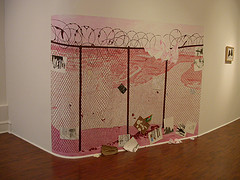
Mauro Zamora’s wall painting depicts a cyclone fence at the border, with all of life on one side and nothing on the other.
Mauro Zamora’s wall painting of a border scene behind a cyclone fence—painted in delicate pink tones that suggest a dream, and with real paper drawings blown up against the painted fence like debris—is haunting and personal. What’s expressed is a longing for beauty and brotherhood that’s both simple and universal.
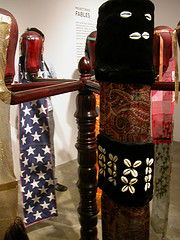
Christopher Myers’ haunting totemic work in Fables at ICA is dedicated to the Ugliest Woman in the world.
“Fables” is a hot grenade toss-fest. Works by Kara Walker, Christopher Myers, Wanda Raimundi-Ortiz and Kanishka Raja talk urgently about beauty, truth, loneliness and the human condition.
Finally Mark Gilbert’s portrait paintings generate heat by sheer depiction of forbidden territory—human deformity. The works are large and graphic, and while essentially “applied” art (their goal is therapeutic for the patients and illustrative for the viewer), they make me think about why painting is better at communicating transgressive material than photography. (Compare say Lisa Yuskavage’s cheesecake paintings with their source material, Playboy. Yuskavage raises ideas—and tittilates. Playboy just titillates.) What Gilbert, like Yuskavage, brings to the table with his paintings (and interestingly, Yuskavage is also painting deformity) is his humanity. And that makes them works worth seeing.
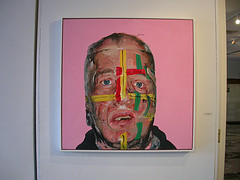
at Klein Art Gallery. The works have power but what really got to me was the gallery handout with a write-up about each patient which I read on the train on the way home. It was in the space of my imagination when I read about the cancers and accidents and sad life experiences that had deformed these patients that my empathy kicked in hard and I was able to put myself into the picture. Then the works became complete. In their presence I was simply a voyeur.
In art, as in most things, geniuses are few and far between. Mostly the art world contains hardworking artists, and what you see is a continuum from good to okay—with occasional zingers that fall off the chart at either end. We won’t know our geniuses until our art historian grandchildren tell us who they are. Until then I’ll keep looking for the heat and thinking about why it matters.
>>”Caleb Weintraub: …with the bathwater,” to Oct. 29. Projects Gallery, 629 N. 2nd St. 267.303.9652.
>>Mauro Zamora: Crossing Borders, to Oct. 8, Seraphin Gallery, 1108 Pine St.
215.923.7000.
>>”Fables,” to Dec. 17, ICA, 118 S. 36th St. 215.898.5911. www.icaphila.org
“Saving Faces” until Oct. 28. The Esther M. Klein Art Gallery at the Science Center, 3701 Market Street, 215.966.6188.


